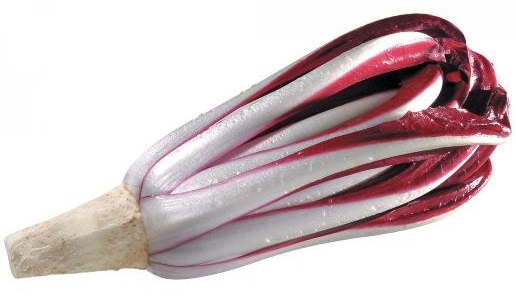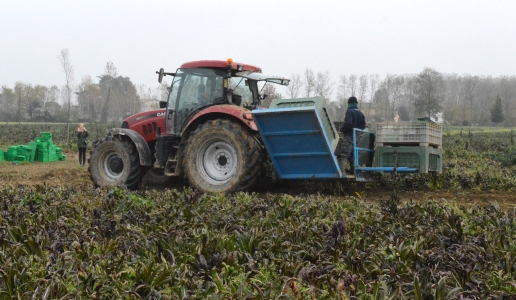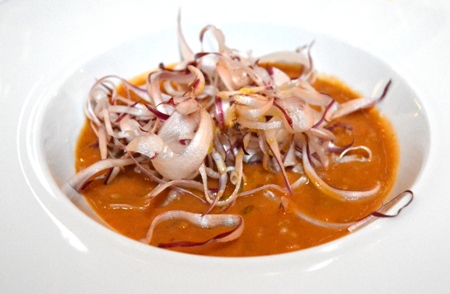Treviso red radicchio, a winter flower

Veneto is a region of farmer traditions and home to an extraordinary product: Treviso red radicchio.
When the opportunity arose to take part in the Radicchio Road Show, a tour from the earth to the table organized by the Veneto Fruit and Vegetable Producers’ Organization (OPO), I was overjoyed. This because I am half Veneto and have fond memories of the mud, tractors and even the bugs and welcomed the opportunity to return home.
According to Managing Director Cesare Bellò, OPO Veneto is an association of producers that protects and promotes regional agricultural products that are more unique than rare, such as the Radicchio Rosso Tardivo (Late-Harvest Red Radicchio).

Late-harvest radicchio can be found from October to April but it is only from November to March that it can qualify, if it meets certain physical (the appearance and length of the flower, length of the taproot and color) and sensorial characteristics (its bitter flavor turns unmistakably sweet), for an IGP (Protected Geographical Indication) classification that certifies and guarantees its quality, origin and characteristics.
The late-harvest radicchio, whether it is IGP or not, can be cultivated in the provinces of Treviso, Padua and Venice. These areas have, aside from a significant presence of biodiversity, two fundamental characteristics:
-
A naturally, heavy clay soil
-
The presence of surface water and springs, in particular the source of the Sile River, which offer an inexhaustible supply of running water.
Aside from the obvious importance of water for a plant‘s growth, in this case, running water plays a specific role for this particular vegetable during the bleaching phase.
Bleaching
Late-harvest radicchio involves a significant amount of manual labor even though technological advances have, especially in the field, simplified harvest phases, sowing and plowing in green manure to ensure the soil is fertile for the next season. However, man’s intervention, patience and experience remain fundamental. The plant’s exterior leaves have to be removed after harvest before the plants are immersed, in the dark, in running water at the source of the Sile River. This stage lasts around 20 days and allows the radicchio to continue to germinate while protected from sunlight allowing its heart to become soft and crispy and develop its red and white color. The spring water guarantees the plant’s survival thanks to a constant temperature (around 15°C) and fresh, running water, two fundamental conditions for the survival of a plant’s roots and veins and thus the plant itself.
After 20 days, the plants are taken out of the water and a selection process begins. More than 50% of the late-harvest radicchio is discarded beginning with the green outer leaves because they are not eaten and served only to protect the precious heart from the light and frost. Having been kept in the dark, the hearts did not develop chlorophyll and this is what gives radicchio its characteristics red and white color.

In Veneto, it is impossible to speak of a gastronomic product outside the context of food on the table. There is not lack of recipes involving radicchio and couple very interesting ones can be found at the Golf Club Cà Amata, in Castelfranco Vebeto, run by Egidio Fior, who is also the owner-operator of the Fior Restaurant in Castelfranco and the creator and backer of the Radicchio d’Oro (Gold radicchio) Prize. He offers it raw and crispy, sliced very thinly to embellish pasta e fagioli or cooks it on a grill where the radicchio obtains a hint of wood and is accompanied by a Port reduction. Both are to die for.
While these are my favorites, there are many other recipes including those from the young chef Simone Pozzebon, joined in the kitchen by Chef Massimo Stocco, who uses it from making an aperitif drink to a sweet dessert.
Radicchio d’Oro
Every year for the past 20 years, Castelfranco Veneto has staged the Radicchio d’Oro Prize, an occasion to celebrate the achievements of journalists, sportsmen, chefs, artists and important people who have distinguished themselves in the course of their careers. For the past 16 years, the hostess of the event has been the reigning Miss Italy, who for the 2018 edition was Carlotta Maggiorana. The 20th edition of the prize was held in Castelfranco’s stately theatre that for the occasion was originally decorated by radicchio made to look like a precious “silk drapes”. This is how they were described by Pier Bergonzi, deputy managing editor at the Gazzetta dello Sport, who this year was awarded with the Radicchio d’Oro Prize for wine and food in recognition of his Gazzagolosa page published in Italy’s leading sports daily.
Further information and some delicious recipes can be found on OPO Veneto’s website (www.ortoveneto.it) and on their social media pages.

 Italiano
Italiano







